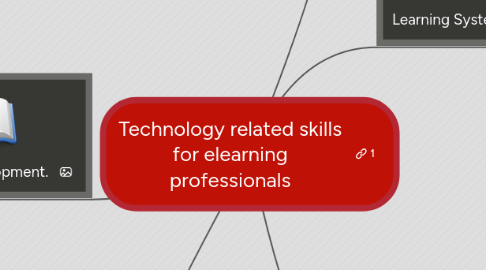
1. Social Learning
1.1. Technologies
1.1.1. Blogs
1.1.2. Wikis
1.1.3. Forums
1.1.4. Videosharing
1.1.5. Microblogging
1.1.6. Communities of Practice sites
1.2. Facilitation / Support
1.2.1. Moderation
1.2.2. Animation
1.2.3. Promotion
1.2.4. Administration / user management
2. Content Development.
2.1. Project Management
2.1.1. Project Files management
2.1.2. Team communication
2.1.3. Source files management
2.1.4. Testing management
2.2. Authoring tools and technologies
2.2.1. Rapid elearning authoring tools
2.2.1.1. Knowledge of Software available
2.2.1.2. Knowledge of online portals available
2.2.2. Understanding of reusable assets
2.2.3. Knowledge of Social learning tools (wikis,
2.2.4. Understanding of programming language specificities (flash, HTML5, Java, XML,...)
2.2.5. Knowledge of functionalities of webinar tools (elluminate, webex, gotomeeting, lynx,...)
2.2.6. Understanding of localization and updates requirements
2.2.7. Understanding of translations requirements (e.g. notions of what .xliff files are)
2.3. Standards
2.3.1. Design Charter
2.3.2. User Interface features
2.3.3. Accessibility features
2.3.4. Technological requirements (Hardware / Software)
2.3.5. SCORM/ AICC norms (or other)
3. Audio-visual production
3.1. Video
3.1.1. Screencasting
3.1.2. Webinar recording / Webcasting
3.1.3. Video production and edition
3.2. Audio
3.2.1. Voice Over / Podcast Recording
3.2.2. Sound editing
3.3. Animation
3.3.1. Flash / HTML5 animation productions
3.4. Image processing
3.4.1. Photographying skills
3.4.2. Photo/image editing
4. Learning Systems
4.1. Administration
4.1.1. User support
4.1.1.1. Q&A managements
4.1.1.2. Aids
4.1.1.3. Direct support (email, phone, chat...)
4.1.2. Management of content
4.1.2.1. Creation of curricula / programmes
4.1.2.2. Presentation of catalogue
4.1.3. Management of social learning features
4.1.3.1. CoP creations / management or rights
4.1.3.2. Moderation / monitoring
4.1.4. Maintenance of portal
4.1.4.1. Interface updates
4.1.4.2. Security updates
4.1.4.3. Look and feel updates
4.1.4.4. Users management
4.1.5. Reporting
4.2. Training
4.2.1. Administrator training
4.2.2. Teachers / Facilitators training
4.2.3. End users training
4.3. Technical skills/knowledge
4.3.1. Types of systems and their specificities
4.3.1.1. Open Source
4.3.1.2. Commercial LMSs
4.3.1.3. SaaS vendors
4.3.1.4. AdHoc solutions
4.3.2. Integration of VLEs/LMSs in the IT architecture landscape
4.3.2.1. Talent Management Suites
4.3.2.2. Integrations
4.3.2.3. Identification / Single Sign on
4.3.3. Rights related issues
4.3.3.1. Security
4.3.3.2. Personal data management
4.3.3.3. Intellectual property rights
5. General communication
5.1. Web-publishing
5.1.1. Management of CMS(s)
5.1.2. Use of Sharepoint
5.2. Filesharing
5.2.1. Virtual hard-drives
5.2.2. Portfolio applications
5.2.3. use of FTP sites
5.2.4. Use of Sharepoint / Google Docs
5.3. Email communication
5.3.1. Templates creation
5.3.2. Management of support boxes
5.3.3. Personalization of messages
